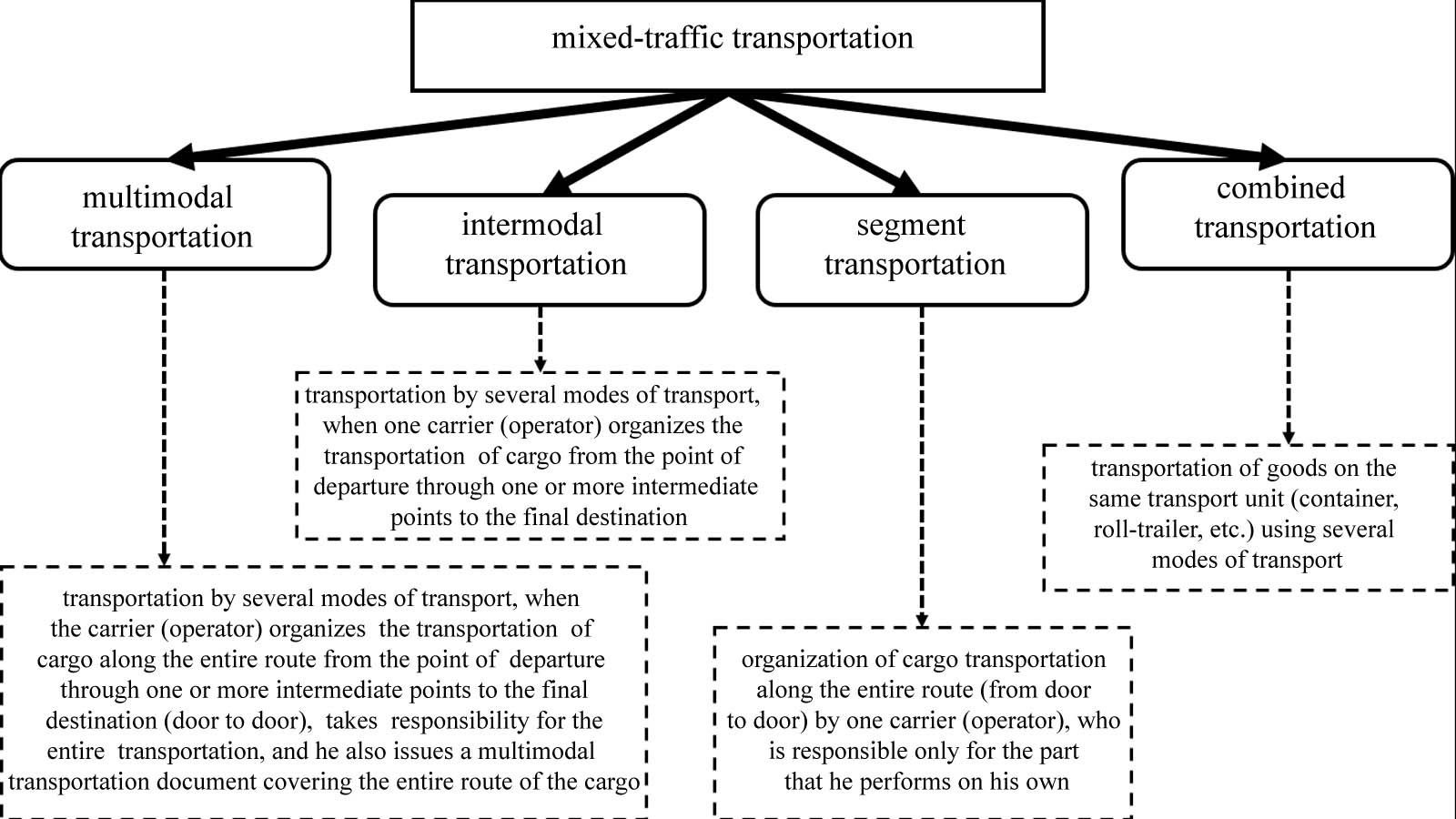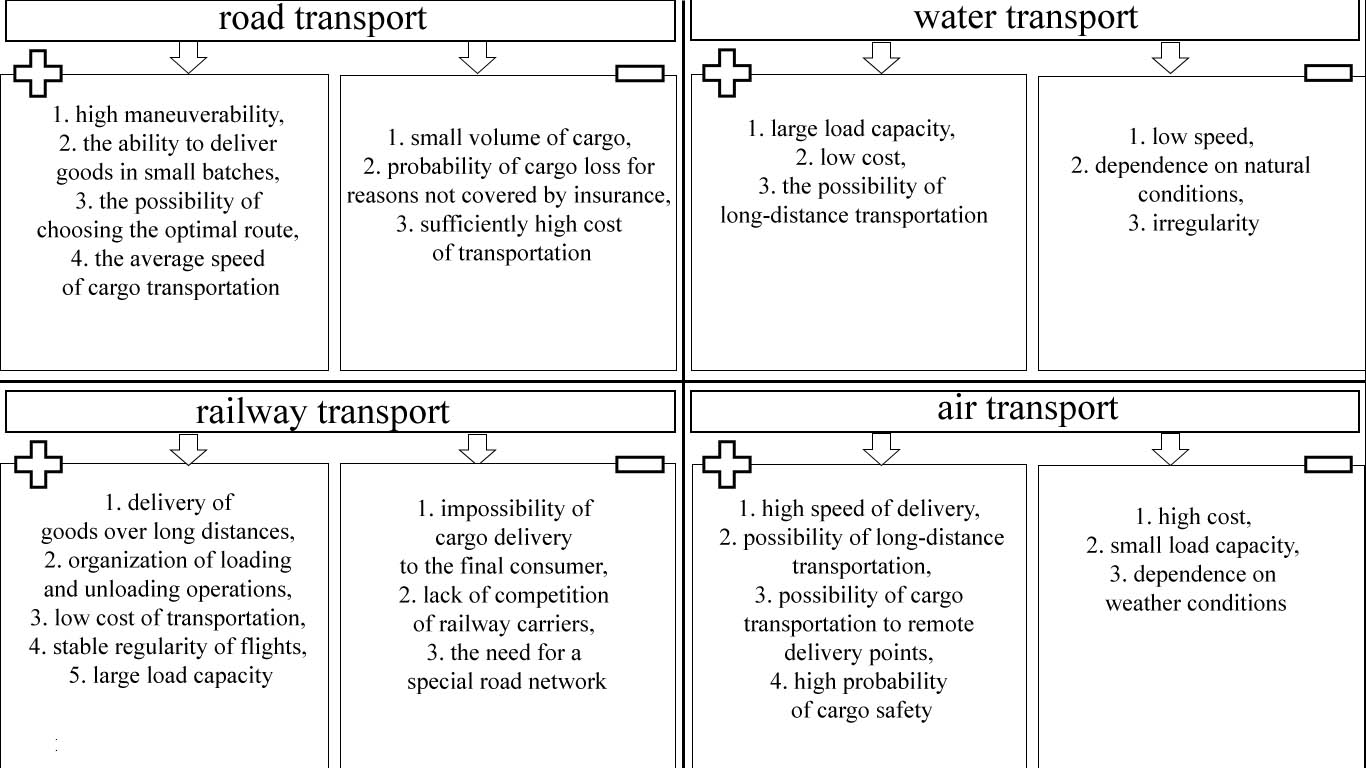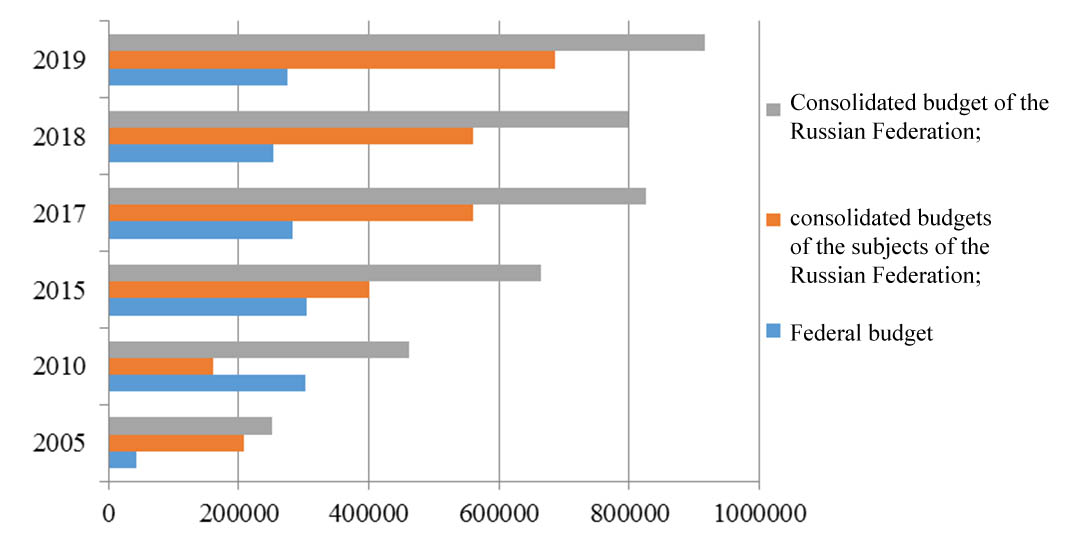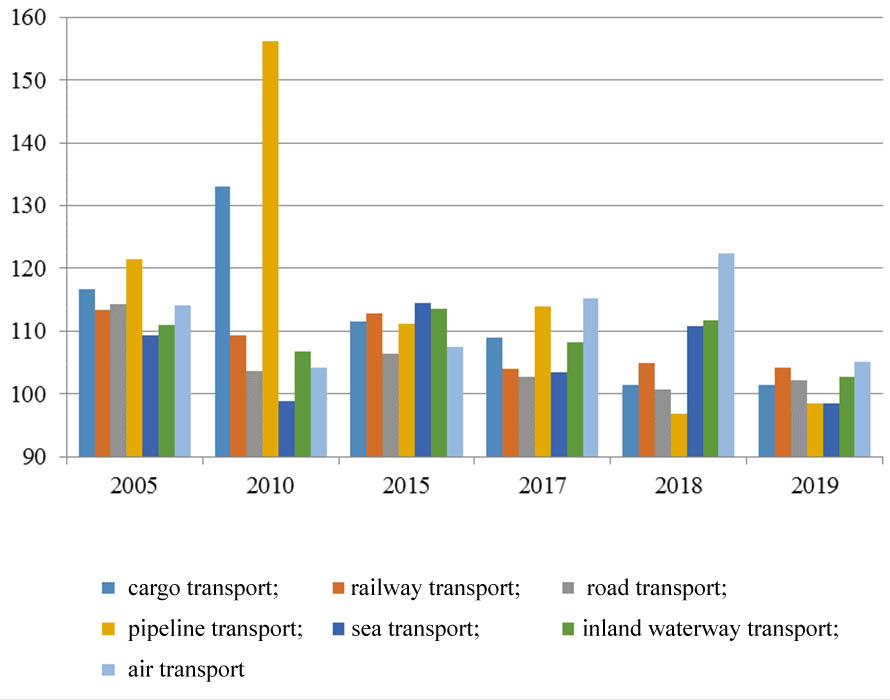Abstract
The article considers the transport industry, which is of great economic and social importance for the country. The social role of transport determines the specifics of market transformations, as well as the spatial accessibility of territories, the quality, standard of living and mobility of the population, the movement of goods and services, and the country's economic activity in foreign markets. A new trend in the development of the transport services market is the international multimodal container transportation. Increasing the efficiency of multimodal transportation is possible today due to the optimization of the system of interaction between the modes of transport used and the direct transportation of goods, cost reduction, optimization of the operation of cargo terminals, the formation and development of a network of transport corridors, the use of new satellite navigation capabilities, reduction of environmental load and fuel economy. Reviewing Russian and foreign studies in the field of multimodal cargo transportation, the authors considered existing approaches of the term multimodal transportation, highlighted the features of multimodal international transportation, compared various transport modes in the transportation process, investigated methods of improving the efficiency of multimodal transportation and criteria for their evaluation.
Keywords: Criteria, efficiency, economic indicators, evaluation, multimodal transportation, transport system
Introduction
The transport industry contributes to the socio-economic development of the country and its regions, contributes to improving the quality of life of the population, ensuring the delivery of raw materials, components, equipment to the place of production and finished products inside and outside the country, as well as the transit of goods.
This industry is always unique. It develops independently and at the same time participates in the organization of activities of other industries, ensuring the receipt of all necessary resources and end products to the consumer. It is important to minimize risks in the entire field of multimodal transportation, improve the legislative framework and document management processes (Nicoleta, 2013, p. 533).
The purpose of transport is to provide the national economy and the population with transportation services as much as possible. If we consider transport services as a resource that is used by the entire national economic complex and the inhabitants of the country, then improving the efficiency of the result of the work of all spheres of the national economy largely depends on the quality, rationality, and economy of transportation (Sossoe & Lebacque, 2017).
Thus, the transport performance indicator cannot be limited by the income minus costs scheme but should be assessed by a combination of technical and economic indicators.
The volume of cargo transportation is growing; therefore, it is necessary to increase the capacity of all types of transport and processes accompanying transportation (Buchananac et al., 2018). The actual tasks for the transport industry will be to increase capacity, reduce the time and cost of transportation, and improve other indicators of the quality of services provided. The consequence of this development of the industry is the receipt of additional income by all participants in the process.
Thus, the issues of evaluating the effectiveness of technology and the organization of multimodal transportation remain relevant for research.
Problem Statement
The complexity of the interaction of modes of transport lies in the different principles of their work. However, with multimodal transportation, it is possible to use the advantages of the modes of transport involved, and such transportation itself has a relatively low cost, contributes to improving the environmental component, ensuring traffic safety, and saving fuel and electricity. For example, the introduction of multimodal transportation in road-rail-water communication provides a reduction in costs by 15–20 % (Trofimenko et al., 2018).
To increase the efficiency of work and reduce risks on different types of transport in multimodal transportation, a combined view is needed to solve the problems of managing such transportation (Sossoe & Lebacque, 2017). The main direction of improving multimodal transportation is to introduce future technologies into the management process, mainly from the field of telecommunications (unified digital platforms, including electronic exchanges, the Internet of things, cloud resources, the development of telematics, the spread of unmanned transport).
As a result of the implementation of these technologies, predictive analytics should become possible, including planning for the repair of rolling stock and forecasting demand (Buchananac et al., 2018).
Research Questions
Features of multimodal transportation
The conceptual framework of cargo transportation carried out by several modes of transport and the classification of four types of mixed-traffic transportation, formulated at the UNCTAD conference in 1996, together with their definitions are presented in Figure 01.

Key features of multimodal transportation:
- delivery is carried out in the presence of one contract with a multimodal operator;
- when organizing cargo transportation, at least two different types of transport are used;
- a multimodal operator may involve third-party carriers (sub-carriers);
- regardless of whether the operator company uses its own transport or engages sub-carriers, the responsibility for compliance with contractual terms to the customer falls on the shoulders of the multimodal operator (Tagiltseva et al., 2021).
Each type of transport has its own specifics, allowing to make a choice regarding sea, road, rail, or air transportation in accordance with the requests of the shipper (consignee) (Figure 02).
The task of transport companies offering services for the implementation of international multimodal transportation is to create the most rational and economical route, depending on the geographical location of the place of delivery, capable of meeting the requirements of safety, safety of cargo, considering the characteristics of a particular type of transported goods. (Tagiltseva et al., 2021)
Knowing the advantages and disadvantages of each type of transport, having certain resources, and having a goal in front of them, the multimodal transportation operator selects the optimal route depending on the deadlines to be met, the price the shipper is willing to pay, and many other factors affecting the transportation of goods.

Main economic indicators of transport
Let us analyze the economic and financial indicators of the country's transport system. One of the main economic indicators of transport is the expenditure of the consolidated budget of the Russian Federation on the development of transport (Figure 03).

The presented data allow us to conclude that the annual increase in incoming financial flows for the development of the transport industry from budgets of different levels, except for 2018, in which a slight decrease was formed.
The net financial result (profit minus loss) allows estimating the final financial result of transport enterprises. This indicator represents the amount of profit (loss) from the sale of goods, products (works, services), fixed assets, other property of organizations and other income reduced by the amount of other expenses. The data on the net financial result are given by the circle of large and medium-sized organizations of the transport industry, broken down by types of transport, in actual prices, structure and methodology of the corresponding years (Table 01).
The above economic indicators form the financial result of the transport company and affect the assessment of the efficiency of cargo transportation.
At the same time, to determine the effectiveness, it is necessary to estimate the transportation costs. The study of the key indicator of the cost of transportation - the freight transportation fare index - shows the change in the actual fares (Figure 4).

A sharp increase in the fare change for transportation by pipeline was observed in 2010. To organize multimodal transportation, it is necessary to identify modes of transport with a decrease in the fare index or its minimum increase. It can be concluded that international maritime transport is stable and fluctuations in the fare index over 10 years are insignificant compared to other modes of transport.
This indicator ensures inclusion in one of the modules of international long-haul transportation –sea transport, which will reduce the cost component (Dyczkowska, 2015).
However, the freight transportation fare index characterizes the change in the actual fare for freight transportation for the reporting period, without considering changes in the structure of transported goods during this period by type and size of shipment of cargo, speed of delivery, distance of transportation, territory of transportation, type of rolling stock, the degree of use of carrying capacity and other characteristics.
Purpose of the Study
The purpose of the study is to assess the effectiveness of the organization of multimodal transportation to ensure the sustainable development of the transport industry of the country. The following tasks were identified:


Research Methods
During the research, the author studied the work of Russian and foreign scientists in the field of multimodal transportation and their management using modern electronic technologies.
More than 50 studies in the field of direct multimodal transport were reviewed. Among them, works devoted directly to multimodal transportation were selected for analysis according to such criteria as: relevance of the study in accordance with the Transport Strategy of the Russian Federation and the departmental target program of the Ministry of Transport of the Russian Federation; compliance with the main trends in the development of multimodal transport systems; the presence of progressive solutions in the work of the most relevant tasks (Danubianu, 2017).
After the analysis of the studies, their results were compared, the main directions and practical significance were highlighted. The authors found the tasks requiring attention and the ways of their solution.
Findings
The effectiveness of multimodal transportation largely depends on the correctness of route planning (Abalkin, 2002). To avoid unforeseen downtime, a multimodal transport operator needs to calculate the schedule of each type of transport, taking into account the time required to stop at congestion points and parking on the way.
The following standards of multimodal transportation services are used to build optimal schedules and routes:
- number of cargo shipments (thousands of tons);
- time of transportation (days);
- intensity of cargo arrival (departure) (tons/day);
- batch size (tons);
- total number of deliveries (units);
- frequency of deliveries per day;
- delivery interval.
The above standards allow us to calculate the optimal batch size and organize transport and logistics interaction in multimodal transportation.
Conclusion
The transport strategy of the Russian Federation until 2030 is focused on the transformation and innovative development of the national transport system to meet the needs of the economy and society with their modern development in high-quality and competitive transport services.
Such development is unthinkable without effective multimodal transportation, and for Russia, which has vast territories and a successful geopolitical location, effective multimodal transportation is important for entering the international market of transport services.
The formulated goal of the transport strategy, which implies the integration of Russia into the global transport network and the expansion of access of Russian operators to the markets of other states, will lead to an increase in the importance of Russia in world transport policy and the transformation of multimodal transportation into a source of income from the export of services.
References
Abalkin, L. I. (2002). The Logic of economic growth. Institute of Economics RAS.
Buchananac, C. A., Chararaa, M., Sullivana, J. L., Lewis, G. M., & Keoleian, G. A. (2018). Lightweighting shipping containers: Life cycle impacts on multimodal freight transportation. Transportation Research Part D: Transport and Environment, 62, 418–432. DOI:
Danubianu, M. (2017). Impact of corporate social responsibility on sustainable enterprise development. Present Environment and Sustainable Development, 11(1), 129–139. DOI:
Dyczkowska, J. (2015). CSR in TSL companies. Transport Problems, 10(1), 97–104. DOI:
Nicoleta, S. (2013). The theory of the firm and the evolutionary games. Annals of the University of Oradea: Economic Science, 22(1), 533–542. https://ideas.repec.org/a/ora/journl/v1y2013i1p533-542.html
Sossoe, K. S., & Lebacque, J. P. (2017). Reactive dynamic assignment for a bi-dimensional traffic flow model. Advances in Systems Science. ICSS 2016. Advances in Intelligent Systems and Computing Vol. 539 (pp. 179–188). Springer, Cham. DOI:
Tagiltseva, J. A., Drozdov, N. A., Vasilenko, M. A., Kuzina, E. L., Laponogova, A. A., & Magomedov, S. Sh. (2021). The System Approach to Making Management Decisions Under Uncertainty Companies. European Proceedings Social and Behavioural Science, 107(351). DOI: 10.15405/epsbs.2021.05.351
Trofimenko, Yu. V., Nekrasov, A. G., Atyev, K. I., & Sinitsyna, A. S. (2018). Modeling principles of the digital infrastructure of it services in sustainable low carbon transport systems. International Journal of Engineering and Technology (UAE), 7(2), 386–389. DOI:
Copyright information

This work is licensed under a Creative Commons Attribution-NonCommercial-NoDerivatives 4.0 International License.
About this article
Publication Date
25 November 2022
Article Doi
eBook ISBN
978-1-80296-127-0
Publisher
European Publisher
Volume
128
Print ISBN (optional)
-
Edition Number
1st Edition
Pages
1-742
Subjects
Sociolinguistics, linguistics, semantics, discourse analysis, translation, interpretation
Cite this article as:
Tagiltseva, J. A., Kuzina, E. L., Vasilenko, M. A., Drozdov, N. A., Korenyakina, N. N., & Glinskiy, A. A. (2022). Effectiveness Assessment Of Multimodal Transportation In Russian Transport And Logistics Market. In D. Bataev, S. A. Gapurov, A. D. Osmaev, V. K. Akaev, L. M. Idigova, M. R. Ovhadov, A. R. Salgiriev, & M. M. Betilmerzaeva (Eds.), Social and Cultural Transformations in the Context of Modern Globalism (SCTCMG 2022), vol 128. European Proceedings of Social and Behavioural Sciences (pp. 607-614). European Publisher. https://doi.org/10.15405/epsbs.2022.11.83

